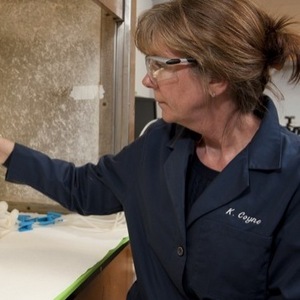Del. professor examines Heterosigma akashiwo algae for biofuels

Photo: Kathy F. Atkinson
June 27, 2013
BY Teresa Messmore, University of Delaware
A hardy algae species is showing promise in both reducing power plant pollution and making biofuel, based on new research at the University of Delaware.
The microscopic algae Heterosigma akashiwo grows rapidly on a gas mixture that has the same carbon dioxide and nitric oxide content as emissions released from a power plant.
“The algae thrive on the gas,” said Kathryn Coyne, associate professor of marine biosciences in UD’s College of Earth, Ocean, and Environment. “They grow twice as fast and the cells are much larger in size compared to when growing without gas treatment.”
The algae also make large amounts of carbohydrates, which can be converted into bioethanol to fuel vehicles. The findings could have industrial applications as a cost-effective way to cut greenhouse gas pollution when paired with biofuel production.
Heterosigma akashiwo is found worldwide in the natural environment. Coyne, an expert in algal blooms, discovered that the species may have a special ability to neutralize nitric oxide—a harmful gas that poses threats to environmental and human health.
Advertisement
Advertisement
That characteristic prompted Coyne and her team to investigate whether the algae could grow on carbon dioxide without getting killed off by the high nitric oxide content in power plants’ flue gas, which had foiled similar attempts by other scientists using different types of algae.
A yearlong laboratory experiment shows that Heterosigma akashiwo not only tolerates flue gas, but flourishes in its presence. The algae also do not need any additional nitrogen sources beyond nitric oxide to grow, which could reduce costs for raising algae for biofuel production.
“This alone could save up to 45 percent of the required energy input to grow algae for biofuels,” Coyne said.
Funded by the Delaware Sea Grant College Program, Coyne and her collaborator, Jennifer Stewart, plan to further study how changes in conditions can enhance the growth of Heterosigma akashiwo. So far, they found a large increase in carbohydrates when grown on flue gas compared to air. They also see correlations between the levels of light given to the algae and the quantity of carbohydrates and lipids present in the organisms.
The researchers are exploring opportunities for partnerships with companies to scale up the growth process and more closely examine Heterosigma akashiwo as a biofuel producer.
Advertisement
Advertisement
The prospects could support a national focus on carbon pollution reduction following President Barack Obama’s major speech this week on climate change.
“Our approach to the issue is to not just produce biofuels, but to also use this species for bioremediation of industrial flue gas to reduce harmful effects even further,” Coyne said.
To learn more about this project, visit the Delaware Sea Grant website.
The University of Delaware was designated as the nation’s ninth Sea Grant College in 1976 to promote the wise use, conservation and management of marine and coastal resources through high-quality research, education and outreach activities that benefit the public and the environment.
UD’s College of Earth, Ocean, and Environment administers the program, which conducts research in priority areas ranging from seafood safety to coastal hazards.
Related Stories
The USDA significantly increased its estimate for 2025-’26 soybean oil use in biofuel production in its latest World Agricultural Supply and Demand Estimates report, released July 11. The outlook for soybean production was revised down.
U.S. fuel ethanol capacity fell slightly in April, while biodiesel and renewable diesel capacity held steady, according to data released by the U.S. EIA on June 30. Feedstock consumption was down when compared to the previous month.
The U.S. EPA on July 8 hosted virtual public hearing to gather input on the agency’s recently released proposed rule to set 2026 and 2027 RFS RVOs. Members of the biofuel industry were among those to offer testimony during the event.
The USDA’s Risk Management Agency is implementing multiple changes to the Camelina pilot insurance program for the 2026 and succeeding crop years. The changes will expand coverage options and provide greater flexibility for producers.
The USDA’s National Agricultural Statistics Service on June 30 released its annual Acreage report, estimating that 83.4 million acres of soybeans have been planted in the U.S. this year, down 4% when compared to 2024.
Upcoming Events










